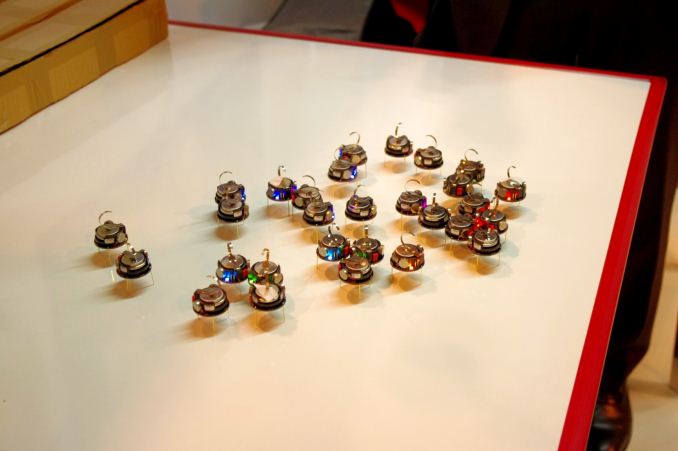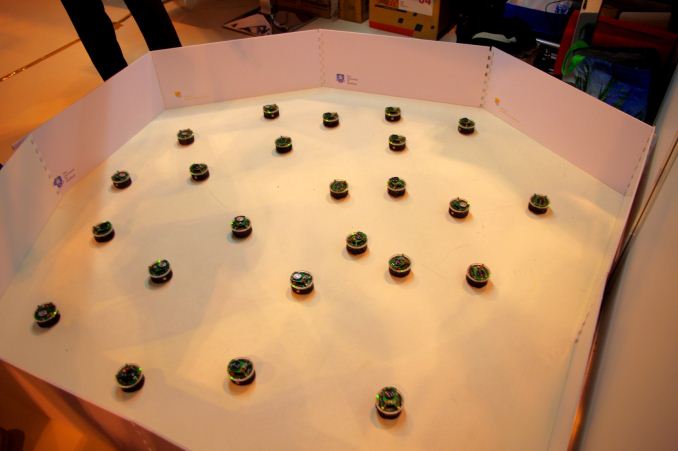The Gadget Show Live, April 2013: Technology in the UK
by Ian Cutress on April 4, 2013 6:30 AM EST- Posted in
- Trade Shows
- UK
- Gadget Show
Cambridge University Eco Racing: Solar Challenge 2013
For those unfamiliar with the Solar Challenge, it is a 3000 mile biennial ‘race’ across the Australian desert with two main goals – fuel efficiency and speed. By using as little initial energy as possible, the Solar Challenge pits energy efficient vehicles against each other to see how fast they can transverse this epic course. One such team is from Cambridge University, present at the Gadget Show Live in order to promote not only themselves but also the event, to investors and the media.
Clearly with the race being in Australia and in the desert, all teams use solar panels. The current CUER design has competed in the past two challenges, and all the entrants have looked very similar – the race in 2013 has had a significant set of rule changes (such as 4 wheels rather than 3), and as such new vehicles have to be designed. All vehicles in the race must have a driver rather than an automated GPS system, and by using student power (which comes very cheap!), the CUER team explained the technology behind their vehicle for the upcoming event.
I have some knowledge of solar cells, as it was a close cousin of my general academic area at university. At the time of those lectures, solar cells were being touted at around 20-25% efficiency; currently the ones being used by CUER are up to 35.5%, which is astonishing for only a few years research. These are expensive, made with space-grade Gallium Arsenide, and might not be the lightest available, but they sure are efficient. In order to save weight elsewhere, we have a carbon fiber monocoque weighing only 30 kilograms but measuring 4.5m x 0.8m.
With the heat in the outback, you obviously need to cool both the components and the driver. The team use 14cm Noctua NF-A14 FLX fans underneath the solar panels, as they provide the best CFM for the lowest power - ~30 CFM for 0.8 W. The solar panels in the new design tilt themselves with the direction of the sun depending on the direction the vehicle is pointing and the time of day; luckily the challenge is typically very dry with low humidity, but on public roads so there is the challenge of a cattle grid or two. CUER is aiming for a vehicle that will hit a top speed of 140 km/h, weight under 120 kg, and complete the course in less than 30 hours.
Website link: http://www.cuer.co.uk
Swarm Robotics: Developing Pack Behavior
The field of Robotics is undoubtedly large and ever expanding. Much of the news we see is about human-like robots and interactions, and how these devices fit into our modern world such that the real life won’t jump back in horror. The other end of the scale is miniaturization, and understanding how a large number of elements in a system (ants in a nest, bees in a hive) can co-operate together to achieve a bigger task or decide what to do as part of a group. Things like finding the best trail to a sugar source and telling everyone else, or bunching together to build a new version of yourself are part of this field, and the Sheffield University group of Dr Roderich Groß was at Gadget Show Live, after being showcased on The Gadget Show media network.
Clearly little robots are interesting, and getting them to decide as a group the best way from A to B, without any interaction, is all about detecting local environment. The first port of call would be computer simulation, but nothing gets the creative juices flowing like a hands-on demonstration. Using e-Pucks and Kilobots, the robots talk to each other via infra red using sensors to determine their local environment and perform the task. Each robot has a localized memory (the smaller the robot, the smaller the memory – in the case of the Kilobots, 32-64 kilobytes), which stores basic commands and an element of ‘swarm memory’. They can be globally controlled for simple commands via infra-red, either by a sensor array (Kilobots) or a programmed remote control (e-Pucks).
The research team are helping program the robots to perform swarm and global activities that have worked well in simulation – special aggregation and segregation into strata (combining then organizing into layers, much like shaking a bowl of nuts the brazils always rise to the top), cooperative transport, and self assembly. Ultimately the goal is replication, such that when being provided with the modular building blocks whether as a swarm the robots will be able to recreate new copies or even modified copies based on the needs of the collective. It works in simulation, but experiment is a different matter entirely.
Once this works on the ‘large’ scale (the kilobots are roughly the diameter of a quarter), the aim is miniaturization. Obviously that has many hurdles in itself, in terms of power, response, memory and application. One application demonstrated is of bringing ‘food’ from a source to a nest; now a marketable goal would be if automated robots could divide and conquer the detection and removal of weeds from a field in agriculture, or help in medical research.
With the collective research funding from national and European sources continually diminishing, researchers and research groups are often looking at other sources of funding for industry – the main barrier to this is working towards a marketable product which may not be readily apparent at the start. The latest research grant awarded to Dr Groß’s research group is one from of the national bodies, to expand on the idea of self assembly. The problem is that this field has many more ideas than there are people and money to go around – so almost any source of funding is welcome.
Incidentally, if any undergraduates or postgraduates are interested in this field and pursuing academia, there are a number of positions available on the research website.















24 Comments
View All Comments
hrrmph - Sunday, April 7, 2013 - link
Ahh yes, but Amazon.co.uk has had the Netgear D6300 WiFi-ac Router / ADSL Modem for 6 months or so. Currently at a mere £170 ($270).Amazon.com in the US only just got that listed and only in the Amazon Market Place from 2 third-party sellers. The French seller only wants $410, while the Irish seller wants $450.
I had to import my Blackberry Z10 from Canada; my Samsung Galaxy Note 2 from Dubai, and my old Philips X523 Dual-SIM from China.
If you are a global thinker, the world is full of apparently "locked washrooms on the highway of life." They can be overcome, but, as you rightly pointed out, it will cost you.
Oh and a UK seller just last week refused to send to the USA some snorkeling gear that is otherwise out of stock elsewhere. Guess that one would cost a plane ticket and the old "ship to hotel room at LHR Terminal 5" trick or ship to friends house in Europe. Been there, done that, on both sides of the Pond.
Not picking on any one country here, but if you think globally, trade barriers are everywhere.
They exist from currency (why does pound sterling demand a 60% premium over the dollar?) to restricted shipping (already covered) to restricted availability (hey Hollywood, how about those DVDs that Obama gave to the Queen that couldn't be played in the UK) to lack of standardization (hate the big British electrical plugs and the whole American special "letter sized" paper thing is inefficient compared to the new world standard A4).
How about the ridiculously un-Spock-logical date format that the USA uses. Who puts the medium sized (medium granuled) units first, the finest units in the middle, and the coarsest ones at the end. We do!
Umm... didn't we lose an interplanetary mission because we Americans couldn't be bothered to switch to metric like the rest of the world. I think the chimps will be converted to metric before we do.
And, whats this quaint thing where Europe has a political union, but still cannot agree on a unified language to trade in. Arabs have a common formal language across 2 continents. Why cannot 'The Continent' do the same?
Driving on the left? I'm tired of switching my brain back and forth depending on who's territory it happens to be in. The right generally prevails worldwide. The left has lost. Let the former empire get over it and get its roads properly untwisted.
Are we solving the world's problems yet? The first step is admitting there is a problem.
Okay, that's enough for now. Maybe the kids can fix this irrational mess that we've been unable to. ;)
-
IglooGaming - Tuesday, April 9, 2013 - link
Glad you enjoyed the dome. We are well aware of some of the issues and these will be ironed out in the next few months. We have some big collaborations lined and hopefully we can launch this very soon. The beauty is that we can take any game made for Trinity and play it immediately in the dome. Also we need to work on the control system, which we have in development. This will be much more accurate. If you want to know more please contact ian@igloovision.comDeviceSquad - Tuesday, November 5, 2013 - link
I went to the SadGit Show on Friday and it was more of the same tat, aside from maybe six items we highlighted on our Device Squad website.BrennaFullen - Thursday, July 4, 2019 - link
This is a very cool exhibition from the University of Cambridge, I think many students were interested in visiting it, you can also attend a dissertation writing service by clicking here , you will find all the necessary materials for writing dissertations, I think it will be interesting for you.